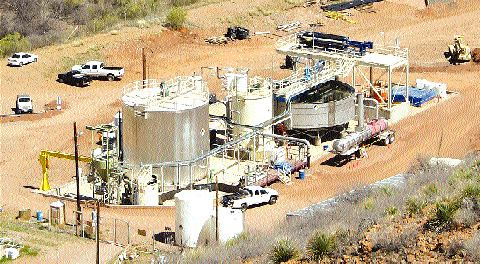Mining has long had a problem with acid mine drainage, and Vancouver-based
According to the U.S. Environmental Protection Agency, acid mine drainage is the single greatest environmental liability facing mining. Companies pay more than US$365 million per year on cleanup costs — and that’s only south of the border. There are roughly 130 minesites in Canada needing some form of treatment.
Aware of the need for a solution to acid mine drainage, BioteQ President Brad Marchant and Executive Vice-President Richard Lawrence devoted 10 years to developing the “BioSulphide” process for water treatment and sulphide reagent production.
As trained metallurgists Marchant and Lawrence developed a process plant that treats acid-contaminated water while, at the same time, recovering a metal-rich byproduct that can be sold for cash. What’s more, the water from the process plants meets discharge water quality criteria south and north of the border.
BioteQ’s first commercial plant in North America incorporating its patented technology was at
“It was really important to get the deal with Breakwater to build our first plant,” says Marchant.
BioteQ recently signed a new contract with CanZinco, a wholly owned subsidiary of Breakwater, for the operation of mine dewatering, water collection and treatment facilities at both the Caribou and Restigouche sites in New Brunswick. The 6-year contract is slated to begin in three months.
BioteQ has another plant at
Under the deal with Falconbridge, BioteQ put up the money for a $1.6-million plant in exchange for 63 monthly payments of $24,500 per month until January 2009, which roughly covers BioteQ’s costs. There is an additional charge of $1.06 per cubic metre of water treated (with a minimum of 550,000 cubic metres slated for treatment each year at Raglan) for a steady revenue stream of $583,000 per year.
A third plant is being commissioned, at the past-producing Copper Queen mine in Bisbee, Ariz. In June 2003, BioteQ and
In May 2003, the company announced that it, in partnership with Quebec Crown corporation
Another 30 water treatment projects are being evaluated worldwide.
“We have quite a large pipeline of projects, and what we are trying to do now is prioritize those that have an urgent environmental need, and second, those that are of a sufficient size from a metal recovery point of view,” says Marchant. “Our current staffing level allows us to build about three [plants] a year.”
For years, mining relied on lime treatment systems to remedy the problem of acid mine drainage, but caught in the filter of these plants was a heavy-metal sludge that was often difficult to dispose of. The key to BioteQ’s success was recovering this sludge and selling it to smelters.
The plant consists of a bacteria tank and a contact tank. The bacteria are isolated in a bio-reactor tank, where sulphur and nutrients are added. Once expelled by the bacteria, the resulting mixture is collected and piped to another tank, where it reacts with contaminated water, thereby causing acids and metals to drop out into a salable metal-sulphide product.
Achieving these results was no easy feat. The project started with a rough idea in 1988 after Marchant sold Coastech Research, the bio-hydrometallurgy firm that he started after leaving
The company initially had problems raising capital and, in December 2002, convinced Ian Telfer, CEO of
“They thought I could help them raise some money,” Telfer says, adding that he realized BioteQ was not going be a “flash-in-the-pan” company.”
Things are not as tight now: BioteQ recently reached a deal with HSBC Canada to provide it with project capital at prime plus 1.5%, and the company plans to open three more plants later this year.
BioteQ has 31 million shares outstanding. A 6.8% stake is owned by a water investment fund controlled by Geneva-based Pictet & Cie, and Toronto-based


Be the first to comment on "Bioteq cleaning up one mess at a time"